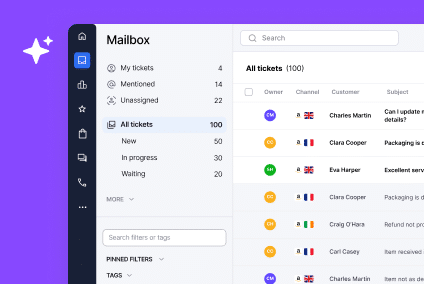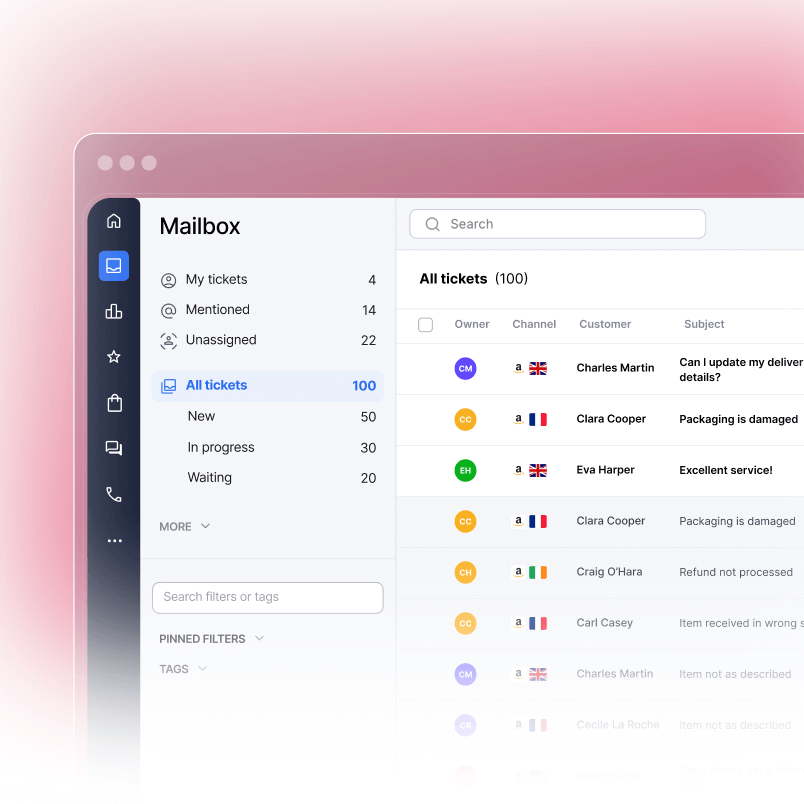An angry customer is a moment. They’re frustrated, possibly at the end of their rope, and they need to feel heard. How you respond in those first minutes determines everything. 89% of customers say a quick response to initial inquiries impacts their choice of company, and you can turn that frustrated customer into a vocal critic who damages your brand, or transform that frustration into loyalty. This guide gives you the exact scripts, de-escalation techniques, and psychological strategies to handle difficult customers with empathy and control.
Whether you’re a frontline support agent, CX lead, or founder managing customer complaints, these tactics work.
Why Angry Customers Happen in Ecommerce
Angry customers aren’t random. They’re the result of broken expectations and lack of control.
Common causes of anger in ecommerce:
- Shipping delays. A customer ordered in good faith. They expected to receive their item by a certain date. When it doesn’t arrive, frustration builds. The longer they wait without an update, the angrier they get. 66% of consumers become frustrated when they have to repeat information to different support staff, and this frustration intensifies when combined with a shipping delay and lack of proactive communication.
- Damaged items. A box arrives at the door. The customer opens it excited. And then they see it. Broken. Defective. Unusable. They feel cheated. They spent money on something that doesn’t work.
- Incorrect orders. They ordered a blue shirt. A red one showed up. A small mistake on your end becomes a big frustration on theirs. Now they have to go through the hassle of returns and exchanges.
- No replies or late replies. A customer sends a message. Hours pass. Then days. No response. They feel ignored. Invisible. This alone can turn a manageable issue into pure anger.
- Refunds denied or delays. They want their money back, and you’re saying no. Or worse, they’re waiting for a refund that hasn’t arrived yet. Money triggers emotion.
The psychological reality is this: in ecommerce, customers have zero physical control. They can’t see, touch, or immediately access what they bought. When something goes wrong, they feel helpless. And helplessness breeds anger. Digital communication makes it worse. There’s no tone of voice, no body language, no human connection. Everything is read as cold, corporate, unhelpful. 58% of customers felt like their complaint was ignored, which is the fastest path to escalated anger.
That’s why empathy isn’t optional. It’s the foundation of de-escalation.
Psychology of Dealing with Angry Customers
When a customer is angry, their brain is in fight-or-flight mode. The amygdala (emotion center) is active. The prefrontal cortex (logic center) is less active. They’re not thinking rationally. They’re feeling threatened.
Your job is to calm their nervous system so logic can return.
Here’s what escalates anger:
- Silence or delays in response. Waiting makes them feel forgotten.
- Defensive language (“That’s our policy”). Sounds like you’re protecting yourself, not helping them.
- Dismissive phrases (“Calm down,” “That’s not a big deal”). Makes them feel unheard.
- Jargon or complex explanations. Confused customers get angrier.
- Being transferred between agents. Repeating their story multiple times feels punitive.
- Here’s what calms anger:
- Quick response. Within 1-3 hours shows you prioritize them.
- Validation of feelings. “I understand this is frustrating” signals empathy.
- Clear next steps. Knowing what happens next reduces anxiety.
- Ownership (“I’ll help you”). Personal accountability matters.
- Authority to help. If they sense you can actually solve their problem, they relax.
- Your three goals in any angry customer interaction:
- Defuse the emotional charge. Get them out of fight-or-flight.
- Resolve the issue. Fix the actual problem or offer a clear path forward.
- Retain the relationship. End on a note that keeps the door open
Best Practices for De-Escalation
Respond quickly. The faster you reply, the better. Aim for 1-3 hours maximum for angry customers. Most platforms flag these conversations, so prioritize them. A quick response signals that you care and you’re taking it seriously. 65% of customers expect faster response times than they did five years ago, and for angry customers, speed is not negotiable.
Validate feelings without admitting fault. There’s a difference between “I understand you’re frustrated” and “We messed up.” One acknowledges emotion. The other is a legal liability. Stick with validation: “I can see why this would be frustrating.”
Stay calm and never match their tone. If they’re aggressive, stay professional. If they’re frustrated, stay empathetic. You set the emotional temperature of the conversation. If you escalate, they escalate. If you stay composed, they often follow. 29.2% of people reported feeling angry when speaking to customer service teams, but this number drops significantly when agents stay calm.
Offer clear, simple next steps. Vague promises make things worse. Be specific. “Here’s what I’m going to do: I’ll process your refund by Friday, send you a tracking number by tomorrow, and follow up with you personally on Monday.”
Know when to escalate internally. Not every situation has a simple fix. If a customer is asking for something outside your authority, escalate to a manager. But do it transparently. “Let me check with my supervisor to see what options we have for you.”
Use your company’s tools to track the full picture. Know the customer’s order history, previous complaints, and what’s been promised already. Nothing makes customers angrier than repeating themselves to someone who doesn’t know their history.
Scripts for Common Angry Customer Scenarios
Scenario 1: Shipping Delays
Customer emotion: Anxious, frustrated, impatient.
Script:
“I completely understand your concern. You ordered on [date] and expected to receive it by [date], and it hasn’t arrived yet. I’d be frustrated too. Let me check the current status for you right now. [Pause, actually check.] Here’s what I’m seeing. Your package is currently [specific location/status]. Based on this, it should arrive by [date]. If it doesn’t arrive by that date, I’m going to personally follow up with you and we’ll figure out how to make it right. In the meantime, is there anything else I can do to help?”
Tone: Empathetic, specific, reassuring. You’re taking their concern seriously and giving them a clear deadline.
Scenario 2: Damaged Product Received
Customer emotion: Disappointed, angry, feeling like money was wasted.
Script:
“I’m really sorry that arrived in that condition. That’s not how we want your product to show up. I can completely understand why you’re upset. Here’s what I’m going to do right away. I’ll send you a replacement with expedited shipping at no cost. You can either send the damaged one back to us using a prepaid label I’ll email you, or if you prefer, you can keep it and we’ll still cover the replacement. Either way, this is on us. You should receive the replacement within [timeframe]. Does that work for you?”
Tone: Apologetic, action-oriented, generous. You’re taking responsibility and offering immediate solution.
Scenario 3: Wrong Item Sent
Customer emotion: Frustrated, feeling like their order was mishandled.
Script:
“Thank you for flagging this. You’re right, this isn’t what you ordered, and I apologize for the mix-up. Here’s exactly what happened: [brief explanation if appropriate]. Here’s what I’m going to do. I’m sending the correct item to you today with expedited shipping. You can send the wrong item back with a prepaid label, or keep it if that’s easier. Either way, no additional charges to you. You should have the right item by [date]. I’m also giving you [discount/store credit] as an apology for the inconvenience. Sound fair?”
Tone: Direct, accountable, fair. You’re owning the mistake and overcompensating slightly to rebuild trust.
Scenario 4: No Response or Late Reply
Customer emotion: Angry about being ignored, feeling undervalued.
Script:
“You’re absolutely right to be frustrated. Your message came in [number] days ago and you didn’t get a response. That’s not okay, and I apologize for that. I’m here now and I’m ready to help. Let me review your issue: [specific issue]. Here’s what I need from you so I can move forward: [specific request if any]. Once I have that, I can [next step]. Thank you for your patience, and again, I’m sorry we missed you initially.”
Tone: Apologetic for the delay, action-focused, responsive. You’re re-engaging and proving you’re attentive now.
Scenario 5: Refund Denied or Delayed
Customer emotion: Angry about money, feeling powerless, possibly panicked.
Script:
“I understand this wasn’t the outcome you were hoping for. Money is important, and I get why you want it back. Let me be transparent about where we’re at. [Explain specific reason for delay or denial, honestly]. Here’s what I can do. [Offer options: process refund immediately, expedited refund, partial refund, store credit, etc.]. I know this might not be exactly what you wanted, but it’s what we can offer. What would work best for you?”
Tone: Honest, transparent, solutions-focused. You’re not hiding behind policy. You’re giving them options and asking what works.
Training Tips for Support Teams
Roleplay common scenarios. Have your team practice these scripts with each other. Not rote memorization, but internalization. The script is a guide, not a word-for-word recitation. Agents should feel comfortable adapting language while keeping the structure.
Use shared macros and templates for consistency. Create an internal library of de-escalation responses for common situations. This ensures that no matter who responds, the tone and approach are similar. It also speeds up response time. Using customer feedback templates as a starting point helps standardize responses across your team.
Empower agents with decision-making authority. If an agent has to ask approval for every small gesture (small discount, priority shipping, etc.), the customer feels more friction. Give agents clear guardrails and the freedom to make small decisions that make the customer feel heard.
Create escalation paths for high-risk cases. Some customers are abusive or demanding things outside policy. Have a clear process for when and how to escalate. Document these conversations. Protect your agents from burnout.
Monitor calls or chats and provide feedback. Use quality assurance tools to listen in or review interactions. Give constructive feedback on tone, empathy, and script usage. Coach agents individually. When coaching, reference successful examples and use data from tools like customer feedback templates that show what worked.
Celebrate wins. When an agent turns around an angry customer and gets positive feedback, celebrate it. Share examples. Build a culture where good de-escalation is valued.
Tools That Help Manage Tough Conversations
Edesk centralizes all customer conversations across channels. It helps you flag angry customers, create templates for common scenarios, and track sentiment over time. Priority support for difficult conversations is built in. Many teams also use customer retention strategies in conjunction with Edesk to ensure that successful de-escalation leads to repeat business.
Gorgias offers sentiment tagging that automatically identifies angry or frustrated customers. You can create macros for common responses and even add tone coaching to help agents match the right voice for different situations.
Zendesk provides escalation rules based on keywords or customer history. If a message contains certain phrases or comes from a repeat complainer, it automatically goes to a senior agent. This prevents junior agents from handling high-risk situations unprepared.
Klaus is a quality assurance platform specifically designed for coaching support teams. It listens to calls or reviews chats and scores them on tone, empathy, and effectiveness. It provides automated coaching recommendations for agents.
Slack integrations with your help desk allow supervisors to create quick huddles when a difficult customer emerges. Real-time collaboration helps solve problems faster.
How to Turn Angry Customers Into Advocates
The relationship doesn’t end at resolution. In fact, that’s when the real work begins.
Follow up post-resolution. A day after you’ve resolved the issue, send a follow-up. “Hey, just wanted to check in and make sure everything is good with you now. Is there anything else I can help with?” This shows genuine care beyond the transaction.
Offer sincere make-goods. Don’t cheap out. A small apology gift matters more than you think. An expedited replacement, a discount on their next order, a personalized note from your CEO. Make them feel valued for sticking with you.
Ask for feedback once they’re calm. After resolution, ask them for feedback on how you handled it. “How did we do? Is there anything we could have done better?” This serves two purposes: it shows humility and gives you intel for improvement.
Track repeat purchases or improved satisfaction. Monitor whether the angry customer buys again. Check if their CSAT score improved in subsequent interactions. These are signs you’ve successfully retained them.
Share their positive feedback internally. If they write a nice review or send a thank-you message, share it with your team. It reinforces that good de-escalation pays off.
The paradox is real: angry customers who get excellent resolution often become more loyal than customers who never had a problem. They’ve seen you at your best in a moment that mattered. They feel heard. That builds trust. 72% of customers will share a positive experience with six or more people, but 13% will share a negative experience with 15 or more people. This means exceptional de-escalation creates advocates, while poor handling creates detractors.
Angry customers are not a threat to your business. They’re a test of your values. Handle them with empathy, speed, and genuine care, and they often become your best advocates. Equip your team with these scripts, empower them with authority, and train them to see de-escalation as a skill worth perfecting. Learn more about customer service best practices and explore how customer retention strategies turn frustrated customers into loyal repeat buyers. The difference shows up in your retention rates, your reviews, and your team’s morale.
FAQs
What should I say to an angry customer?
Start with validation and empathy. “I understand why you’re frustrated. Let me see what I can do to help.” Then listen without interrupting. Repeat back what you heard to show you were paying attention. Finally, offer clear next steps. Avoid defensive language or excuses. Take ownership where appropriate.
How do I train support agents to stay calm?
Model it. Show agents that staying calm is normal and effective. Role-play difficult scenarios so they’re prepared. Give them scripts to lean on when emotions run high. Remind them that the customer’s anger isn’t personal. It’s about the situation. Also, make sure your team isn’t understaffed or overworked. Burnout makes it harder to stay calm.
Should I ever refund an abusive customer?
Depends. If a customer is being rude but legitimate about their complaint, refund them or make it right. You want them as a customer despite the tone. 45% of customers want their issues resolved in the first interaction, so a refund might be the fastest resolution path. If a customer is threatening, using hate speech, or being abusive to your agent, you can refuse service. Set boundaries. Protect your team’s mental health. But don’t confuse “angry” with “abusive.” Angry customers often become loyal customers. Abusive ones rarely do.
What tone works best in written replies?
Warm but professional. Avoid cold corporate language. Avoid casual slang. Think of how you’d talk to a friend’s parent you respect. You’re being helpful and human, but also credible. Use contractions (I’m, you’re, we’ve). Use “we” instead of “I” when appropriate. Include the customer’s name. Show you actually read their message. Be concise—angry customers don’t want to read a wall of text. 70% of customers expect anyone they interact with to have the full context of their situation, so personalization in tone matters.
Can an angry customer ever be a problem I shouldn’t take on?
Yes. If a customer is harassing your team, making unreasonable demands you genuinely can’t meet, or abusing the system, you can set boundaries. You don’t owe anyone excellent service if they’re treating your people poorly. Protect your team first. Then decide if the customer is salvageable. Sometimes the right move is to politely discontinue the relationship.
How quickly should I respond to an angry customer?
Within 1-3 hours is ideal. Any longer and they feel forgotten. If it’s in the middle of the night or outside business hours, acknowledge receipt with an auto-reply: “We got your message and will respond by [time].” Then follow through. Speed signals respect.




